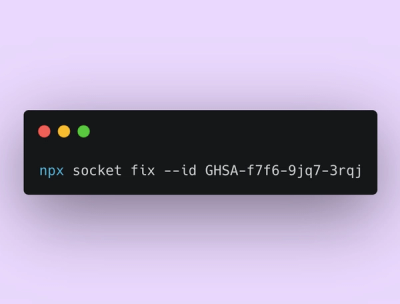
Product
Rust Support Now in Beta
Socket's Rust support is moving to Beta: all users can scan Cargo projects and generate SBOMs, including Cargo.toml-only crates, with Rust-aware supply chain checks.
@davids-devel/rocket-translator
Advanced tools
Translate HTML code to Vue or React.
To install simply: Clone the repository and install dependencies.
npm i -g rocket-translator
You can convert this:
<div>Hello {name - state - "World"}!</div>
into this:
import React, {Component} from "react";
class MyComponent extends Component {
super();
this.state = {
name:"World"
};
render(){
return(
<div>Hello {this.state.name}!</div>
)
}
}
export default MyComponent;
or this:
<template>
<div>Hello {{name}}!</div>
</template>
<script>
export default {
name:"MyComponent",
data(){
return {
name:"World"
}
}
}
</script>
To use, simpy create a HTML file, with the code to translate, and run:
rocket [mode] path/to/file.html [output folder]
The mode may be -v to Vue or -r to React.
The output folder is optional, if this is not defined will create a folder named dist.
A State in a Vue or React component, are a way to set data that affect the view, and when this changes, the component re-render the view.
To get values from the HTML, we must declare into {}. And to the declare a state, we have 2 modes to set it: Simple, With Value.
The Simple mode, is declared writing only the state name into the template and writing the type: state.
Example:
<div>{myState - state}</div>
In the With Value mode, is declared when, we write the state name, the type: state and the value for this state.
Example:
<div>{stateName - state - "Some Value"}</div>
The value may be String, Number, Boolean,Array and Object.
And in the simple case, we obtain the next component state.
In Vue:
data(){
return {
myState:""
}
}
And in React we obtain:
this.state = {
myState:""
}
In the With value case we obtain. In Vue:
data(){
return {
stateName:"Some Value"
}
}
And in React:
this.state = {
stateName:"Some Value"
}
To know more about states, and Javascript Management. You can see JavaScript Management section.
The props in a component, are data that a parent (container) component pass to a child component.
And like the state, we may declare a prop with this format {propName - prop}.
Example:
<div>{parentData - prop}</div>
And declaring a prop, the final template will render, in Vue:
props:{
parentData:{
type:String,
required:true,
default:"Hello World"
}
}
And in React, pass the props trought the Component Constructor and auto declares the props.
constructor(props){
super(props);
}
render(){
return(
<div>{this.props.parentData}</div>
)
}
A Computed propierty is a function that return a String or Number value, and this is render on the template. And to declare a computed propierty, simply we can set the computed propierty name and the type: computed.
<div>{computedName - computed}</div>
This will create a computed propierties that returns a Hello World. And to set your own computed propierty, you must add a script tag and create a function named like the computed propierty.
<div>Hi I Am {fullName - computed}!</div>
<script>
function fullName() {
var name = "Foo";
var lastName = "Bar";
return `${name} ${lastName}`;
}
</script>
Too know more about Javascript Management go to JavaScript Management section.
A Method is a function executed by an event on the final render or by the render. Is not necesary declare the method only set the event into the tag.
<button onclick="hello()">Say Hello</button>
<script>
function hello() {
alert("Hello World");
}
</script>
To import a component inside the main component. Only add the tag with the component syntax.
<MyComponent />
And to add a attr with a state value add : on the attr front.
<MyComponent :my-bind-attr="stateName" />
Para declarar un State Watcher añadan la palabra reservada watch seguido del nombre del estado igual a la funcion a ejecutar cuando cambie el estate.
watch stateName = e => {
//Handle State
}
To handle a input, you must add the attr name on the input tag, and the value will be take to add a state with that name.
<input type="text" name="username" />
On Vue will render.
<template>
<input type="text" v-model="username" name="username"/>
</template>
<script>
export default {
name:"MyComponent",
data() {
return {
username:""
}
}
}
</script>
On React.
import React, {Component} from "react";
class MyComponent extends Component {
constructor() {
super();
this.state = {
username:""
}
}
inputHandler({target}){
const value = target.type === 'checkbox' ? target.checked : target.value;
const name = target.name;
this.setState({
[name]: value
})
}`
}
To declare a conditional, add the if tag, with the cond attr, where cond is the condition to evaluate.
Example:
<if cond="auth">
<span>Congratulations! you are Sign in this platform</span>
</if>
And you can set it with an else tag.
<if cond="password.length < 6">
<span>Password must have more of 6 characters</span>
</if>
<else>
<span>Password is very strong</span>
</else>
Like the conditionals, add a loop is't very easy, add a for tag, with the val attr.
<for val="varName in stateName">
<span>{varName}</span>
</for>
Note: if you see that some feature is missing, you can write an issue, and tell what feature is missing.
To contribute you can Join to our Slack channel for more info. (Info in Spanish)
Coming soon we add an english thread.
FAQs
Translate your HTML files to React.js and Vue.js
We found that @davids-devel/rocket-translator demonstrated a not healthy version release cadence and project activity because the last version was released a year ago. It has 1 open source maintainer collaborating on the project.
Did you know?

Socket for GitHub automatically highlights issues in each pull request and monitors the health of all your open source dependencies. Discover the contents of your packages and block harmful activity before you install or update your dependencies.

Product
Socket's Rust support is moving to Beta: all users can scan Cargo projects and generate SBOMs, including Cargo.toml-only crates, with Rust-aware supply chain checks.

Product
Socket Fix 2.0 brings targeted CVE remediation, smarter upgrade planning, and broader ecosystem support to help developers get to zero alerts.

Security News
Socket CEO Feross Aboukhadijeh joins Risky Business Weekly to unpack recent npm phishing attacks, their limited impact, and the risks if attackers get smarter.